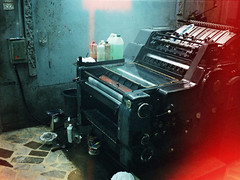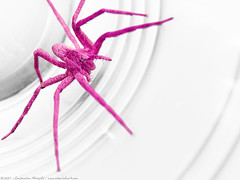The CMYK Colour Model aka Process Colour
 The CMYK colour model is made up of Cyan, Magenta, Yellow and Black (or Key). Unlike RGB (Red, Green, Blue) which are what your computer and TV screen colours are made up of, Cyan, Magenta, Yellow and Black are the colours a printer works with. The CMYK colour model is also referred to as ‘process colour’ or ‘full colour’. You could regard the CMYK model as the ‘primary colours of the printing process’.
The CMYK colour model is made up of Cyan, Magenta, Yellow and Black (or Key). Unlike RGB (Red, Green, Blue) which are what your computer and TV screen colours are made up of, Cyan, Magenta, Yellow and Black are the colours a printer works with. The CMYK colour model is also referred to as ‘process colour’ or ‘full colour’. You could regard the CMYK model as the ‘primary colours of the printing process’.
CMYK is a subtractive colour space, i.e. having 0% CMYK will make the colour White.
How to Write CMYK Colour Values
A process colour breakdown is written in percentages of Cyan, Magenta, Yellow and Black. For example:
- White: C0 M0 Y0 K0
- Black: C0 M0 Y0 K100
- Red: C0 M100 Y100 K0
- Green: C100 M0 Y100 K0
Conventional Printing Process
When media such as books, business cards, etc. are printed using the process colours, this is known as printing in full colour. Each of the four colours is printed onto the page as a separate print pass, first Cyan, then Magenta, then Yellow and finally Black. Different percentages of each colour will give lighter or darker shades and when combined with the other three will produce an infinite number of colour variations.
Why Printers Prefer Not To Use Your Word Documents to Print Full Colour
 Aside from a list of other specs required for sending a document to the printers, most computer programs work in the screen colour model, RGB. When your document goes off for conventional printing, the printers need it to be broken down into CMYK. This means that the RGB colours you might have spent hours on getting just they way you want them, land up being converted to CMYK and very seldom return a 100% accurate colour conversion.
Aside from a list of other specs required for sending a document to the printers, most computer programs work in the screen colour model, RGB. When your document goes off for conventional printing, the printers need it to be broken down into CMYK. This means that the RGB colours you might have spent hours on getting just they way you want them, land up being converted to CMYK and very seldom return a 100% accurate colour conversion.
The most important difference is that when RGB ‘black’ is converted to CMYK, it only converts to Cyan, Magenta and Yellow, so there is no solid black produced. This turns out quite ‘dirty’ when, for example, a full colour book is converted from RGB to CMYK. All the text which is supposed to be black is passed through the printer three times as percentages on the Cyan, Magenta and Yellow pass, while the Black pass is empty. Instead of a crisp, clear, solid black text, the result is a ‘dirty’, and potentially out of focus, dark brown.
When you’re preparing something for print, it is best to use a program that has the CMYK colour model available, for example a graphics program such as Illustrator or Photoshop, or a typesetting program such as InDesign or PageMaker. Alternatively, Microsoft Office Publisher has the CMYK palette available too.
[Images: Flickr, all images available under the Creative Commons license]



